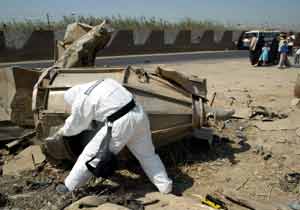
Greenpeace scientist Dr Rianne Teule measures radioactive levels
A team of Greenpeace radiation experts has discovered nuclear material and high levels of radioactivity in villages surrounding the looted nuclear site at Tuwaitha, south of Baghdad.
The Greenpeace team found high radiation levels in a series of houses including one source measuring 10,000 times above normal. Another reading 3000 times background levels was taken just outside an Iraqi primary school. The team also retrieved a canister the size of a small car containing significant quantities of mined uranium or 'yellowcake' that had been dumped on a busy section of open ground. Despite the military being aware of its presence, locals say it has been left open and unattended for more than 20 days.
To highlight the US and UK's failure to safeguard the nuclear site, a convoy of vehicles bearing Greenpeace banners, along with a single activist bearing a white flag today, (Tuesday 24th June), returned the yellow cake canister to the US military guards stationed at the heart of the nuclear plant.
Speaking from outside the plant Greenpeace nuclear campaigner Mike Townsley said,
"If this had happened in the UK or the US, the villages around Tuwaitha would be swarming with decontamination teams and the people given immediate medical check-ups. The people of Iraq deserve no less from the international community. Ignoring them is a scandal."
In just a weeklong survey Greenpeace has found abandoned radioactive sources scattered across the community. Much of the material was looted by villagers who are using it for house building and storage for food and water without realising the potential danger. There are consistent and repeated stories of unusual sickness after coming into contact with material from the Tuwaitha plant.
The UK and the US have so far refused to allow the UN nuclear experts, the International Atomic Energy Agency (IAEA), to carry out proper documentation and decontamination in Iraq. The US authorities in Baghdad have insisted upon retaining responsibility for protecting human health but consistently deny there is a risk to the local population. (2)
Stephen Tindale, Greenpeace UK executive director said,
"Tony Blair needs to face up to his responsibility. Having invaded Iraq, he now has a moral obligation to protect the Iraqi people. Instead he and Bush are actually hampering the UN's efforts to find and clean up nuclear material."
Notes
1. The Tuwaitha nuclear storage facility south of Baghdad was left unsecured by occupying forces and was heavily looted. In contrast, oil pipelines and the oil ministry was immediately secured. Just days after the cease-fire, British Museum officials were brought in to reclaim stolen artifacts. It was nearly two months before IAEA inspectors were allowed to return, and then with an inadequate remit.
2. Washington Post - June 6th 2003 - "The U.S. military has conducted an initial radiation survey in the villages, and a health study is set to begin in coming days. "There is no health risk to the population or the soldiers guarding the site," said Mickey Freeland, part of the U.S. team involved in the hunt for Iraqi weapons of mass destruction.
For more information please contact Greenpeace press office on 020 7865 8255

